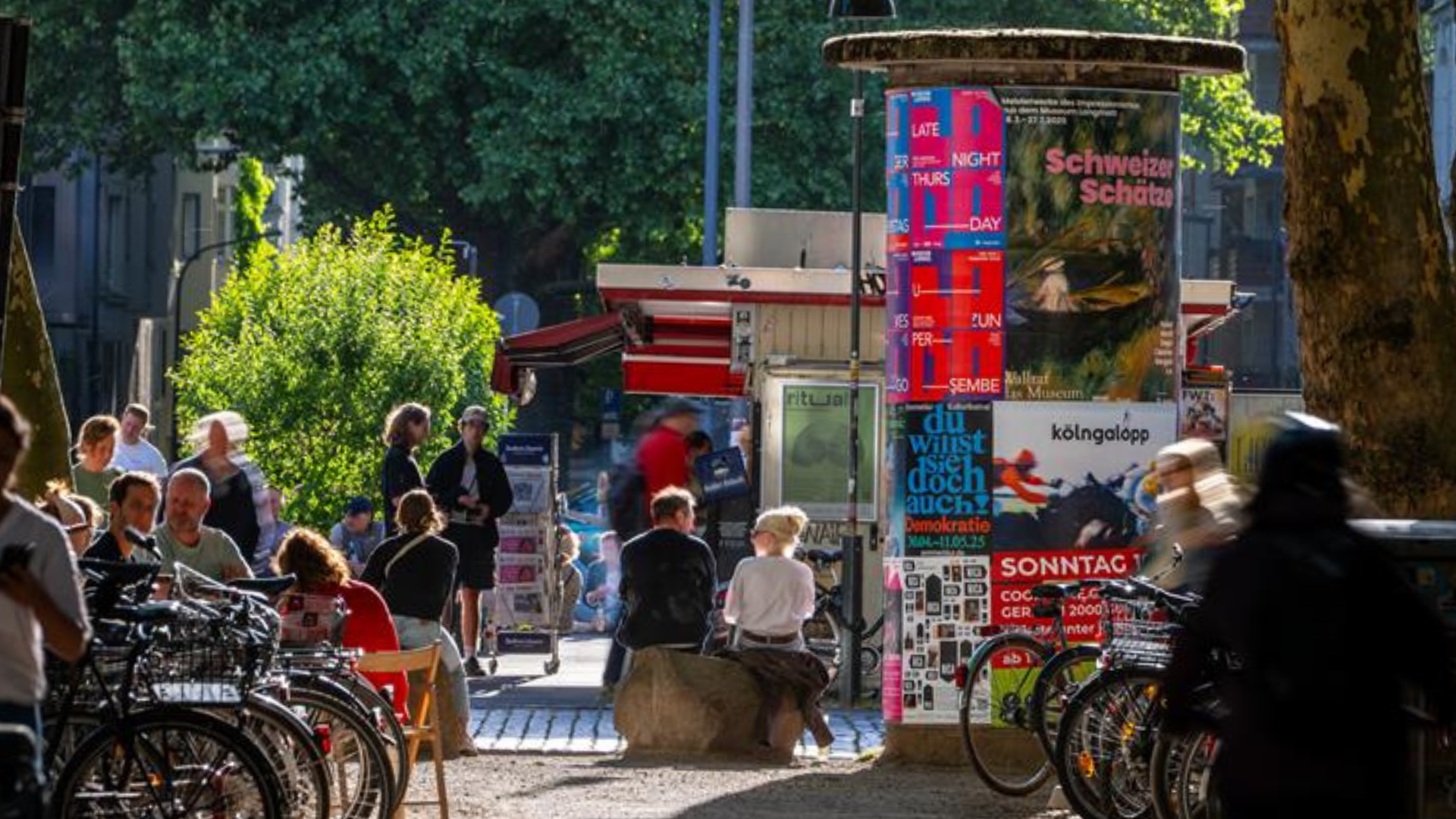
13. June 2025
Press kit
170 years of the advertising column: Ströer celebrates the birthday of an advertising icon
On 1 July, the advertising column will celebrate its 170th birthday. Ever since it was invented in 1854, it has shaped the cityscape, and it remains an indispensable medium in public spaces to this day. Ströer is honouring this tradition-steeped column as a symbol of innovation, change and sustainable urban design with its own anniversary motif, which can be seen in various German cities such as Cologne, Hamburg, Leipzig and Munich. Today, Ströer still markets around 13,000 columns throughout Germany.
The advertising column was introduced in 1854 in Berlin by Ernst Litfass, a German printer and publisher, to enable posters to be displayed in an orderly manner in public spaces. Until then, it was common practice to stick posters and notices randomly on walls, fences or trees, which left a chaotic impression in many places. The first advertising column was erected in Berlin on 1 July 1855. At that time, the advertising column provided a public space that was equally accessible to all sections of the population for the first time. Information could be accessed free of charge by any passer-by, regardless of their social status or level of education. It was also referred to as the newspaper of the common man or the newspaper of the street. The content on the column was varied: in addition to commercial advertising, it also featured cultural announcements, political messages and official notices. The advertising column quickly spread throughout German cities and later to other countries. It became an integral part of the street scene and, over the decades, developed into a symbol of urban culture and communication. Even today, in the digital age, advertising columns are still an integral part of the cityscape and serve as a source of information for culture, events and advertising. They offer a wide reach, are easily noticeable and build trust through their presence in public spaces.
“The advertising column is much more than a piece of city history – it is a living medium that is constantly reinventing itself and also has a secure position in the digital age,” says Alexander Stotz, CEO of Ströer Media Deutschland GmbH. “It combines tradition with innovation and demonstrates the importance of public communication in urban spaces. The advertising column symbolises the link between the past and the future in outdoor advertising. It proves that analogue media still have their strengths in the digital age – especially when they are intelligently further developed.”
Ströer focuses on innovative utilisation concepts that combine traditional outdoor advertising with digital media and sustainable approaches. In Hamburg and Stuttgart, Ströer is marketing the first digital columns, which are integrated into the high-reach public video network in public spaces. Current examples also show that advertising columns provide impetus for sustainable urban development. Among other things, Ströer is promoting the greening of advertising columns: planted columns not only enhance urban living spaces, but also contribute to the urban climate. In addition, advertising columns are increasingly serving as warning disseminators – for example, in the event of storms or major events – and thus support public safety. This April, Advertising Column 4.0 was unveiled in Darmstadt as a collaboration between the LOEWE centre emergenCITY, the Technical University of Darmstadt and the media company Ströer. As part of the research collaboration, the classic advertising column is experiencing a renaissance as a warning disseminator. The idea: if other communication media such as mobile phones, the internet or television fail during a protracted power outage, the energy self-sufficient Advertising Column 4.0 can continue to provide people with information. Advertising Column 4.0 is a new attachment that is added to existing advertising columns. It is equipped with three LED displays that can show information and warnings from the authorities. The digital display is powered by a methanol fuel cell. Two photovoltaic modules on the roof ensure that the receiver, which the fire brigade can control by radio, is on standby. In the event of a power failure, the advertising pillar can be operated for up to 72 hours. In the future, the new warning disseminator is also to be integrated into the German government’s modular warning system.
Disclaimer
This press release contains "forward-looking statements" regarding Ströer SE &Co. KGaA ("Ströer") or the Ströer Group, including assessments, estimates andforecasts regarding the financialposition, business strategy, plans and objectives of managementand the future business activities of Ströer or the Ströer Group. Forward-looking statements are subject to known and unknown risks, uncertainties and other factors which may causethe results of operations, profitability, performance or achievements of Ströeror the Ströer Group to be materially different from any futureresults of operations, profitability, performance or achievements expressed or implied by such forward-looking statements. These forward-looking statementsare made as of thedate of this press release and are basedon numerous assumptions that mayalso prove to beincorrect. Ströer makes no representationand assumes no liability with respect to thefair presentation, completeness, correctness,adequacy or accuracy of the informationand assessments contained herein. The information contained inthis press release is subject to change without notice. It may beincomplete or abbreviated and maynot contain all material information relating to Ströer or the Ströer Group. Ströer does notundertake any obligation to publiclyupdate or revise any forward-looking statements or other information contained herein, neither as a resultof new information, future events nor otherwise.

